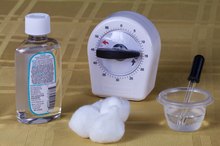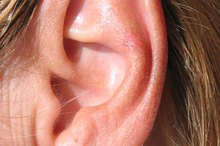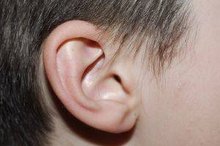What does fact checked mean?
At Healthfully, we strive to deliver objective content that is accurate and up-to-date. Our team periodically reviews articles in order to ensure content quality. The sources cited below consist of evidence from peer-reviewed journals, prominent medical organizations, academic associations, and government data.
The information contained on this site is for informational purposes only, and should not be used as a substitute for the advice of a professional health care provider. Please check with the appropriate physician regarding health questions and concerns. Although we strive to deliver accurate and up-to-date information, no guarantee to that effect is made.
How to Get Rid of Flaky Earwax
Many people think earwax is unsanitary, but surprisingly, your ears would be even dirtier without it. Earwax collects dirt, oils and dead skin cells as they make their way through your ear canal. At the end of the canal, the wax turns dry and flaky, then falls out of your ear by itself. If you have too much wax, though, you may want to remove it before it builds up. Contrary to popular belief, a cotton-tipped swab doesn't help. In fact, it may push wax further back into the ear canal. Remove excess earwax safely to avoid harming your delicate ears.
Soak a cotton ball with an over-the-counter ear drop solution. Or use baby oil, hydrogen peroxide, saline solution or mineral oil. Use water-based products to break up earwax and oil-based ones to soften the wax so it slides out easily 24.
How to Remove Ear Wax
Learn More
Tilt your head to one side so the opening of your ear faces up, then hold the cotton ball over your ear canal. Do not push the cotton ball into the canal 2. Hold your head in this position for about a minute. This allows the liquid to drip into your ear canal and loosen or break apart the wax.
Tilt your head to the other side to allow the wax to drain out. Use a cloth or tissue to collect the liquid and wax as it comes out.
Baking Soda & Water for Ear Wax
Learn More
If your ears still feel clogged, fill a bulb syringe with water and squirt some water into the ear canal to help remove any remaining wax.
Repeat this process for the other ear, if necessary.
Tips
If you have a chronic problem with earwax, consult with an ear, nose and throat doctor to have it removed safely. Visit a doctor if your ears feel clogged or if you think your hearing is worsening because of wax buildup.
Warnings
If you have an ear perforation, do not put any type of wax softeners in your ears. A doctor can tell you whether you have a perforation. Signs include tenderness, pain and a rash.
Wearing ear plugs, ear-bud headphones or hearing aids for a long period of time may worsen wax compaction.
Related Articles
References
- The Harvard Medical School Family Health Guide: Got an Ear Full? Here's Some Advice.
- The Dr. Oz Show: Earwax On, Earwax Off
- MedicineNet.com: Ear Wax
- The Wall Street Journal: The Good, the Bad and the Eww of Earwax Removal
- Mittal A, Kumar S. Role of pH of external auditory canal in acute otitis externa. Indian J Otolaryngol Head Neck Surg. 2014;66(1):86-91. doi:10.1007/s12070-013-0684-0
- Schwartz SR, Magit AE, Rosenfeld RM, et al. Clinical practice guideline (update): Earwax (cerumen impaction). Otolaryngol Head Neck Surg. 2017;156(1_suppl):S1-S29. doi:10.1177/0194599816671491
- Wright T. Ear wax. BMJ Clin Evid. 2015;2015:0504.
Writer Bio
Melissa King began writing in 2001. She spent three years writing for her local newspaper, "The Colt," writing editorials, news stories, product reviews and entertainment pieces. She is also the owner and operator of Howbert Freelance Writing. King holds an Associate of Arts in communications from Tarrant County College.









